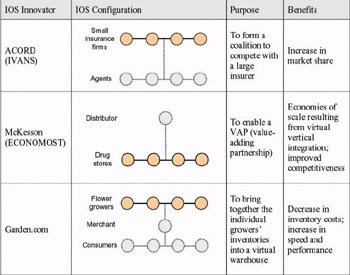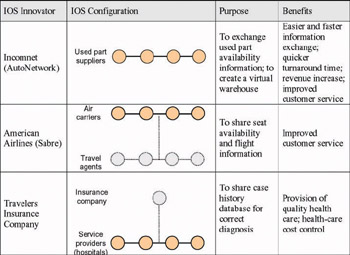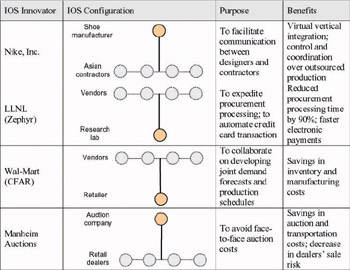Discussion
|
| < Day Day Up > |
|
The IOS examples given for each of the four categories have been grouped as such, based on the two dimensions, including the way that they are configured and their system support levels. And, it is presumed that the examples within each category share common characteristics.
Implications for IOS Planning
Now we can examine the systems to draw useful implications for IOS planning, such as purpose, benefits, supporting strategies, etc.
Resource-Pooling IOS
Resource-pooling IOSs purport to form a coalition to create a market power or to distribute investments among the participating firms (Table 1). These systems make the separate organizations appear large, making available the resources needed to compete with a strong player or to reduce the risk or financial burden of IT construction. A growth strategy may be implemented through an IOS of this type, as the systems may help to broaden the market share by strengthening corporate competitiveness. However, the firms performing a common value activity may be confronted with conflicts of interest, unless a common set of goals can initially be anticipated and clearly spelled out.
Table 1: Characteristics of resource-pooling IOS

Complementary Cooperation IOS
IOS examples in this category are shown to strongly reveal the interdependency relationships among the participants, as the firms need to depend on one another for reciprocal advantages (Table 2). The airline companies or Citibank will not be able to attract a new customer segment on their own. How well related products or services are packaged into an attractive offering is likely to determine their success. Implementation of these systems would be effective when linked to a differentiation strategy aimed at creating a unique image in combination with a strategy tailored to the needs of potential customers.
Table 2: Characteristics of complementary cooperation IOS

Operational Cooperation IOS
The IOS examples presented above illustrate firms that aim to improve customer service by cooperating with firms performing identical value activities; they are characterized by their using joint databases to facilitate information sharing. Access to this joint database affects the ability to perform day-to-day operations in a flexible manner. This, in turn, influences the quality of customer service. For this reason, firms planning to introduce operational cooperation IOS will be better off tying it with a differentiation strategy with a focus on customer service improvement (Table 3).
Table 3: Characteristics of operational cooperation IOS

Operational Coordination IOS
The primary motive for creating this type of IOS is cost efficiency enabled by effective coordination of a firm’s operations through the industry value chain (Table 4). The first example is based on virtual vertical integration, while the other three illustrate the buyer–seller relationship. Planning for this type of IOS will have to center around a cost leadership strategy geared toward cutting the operational costs (ordering/inventory, shipping, production, etc.).
Table 4: Characteristics of operational coordination IOS

Comparing the Four Types of IOS
While all types of IOSs share the common characteristic of interconnecting businesses to enable dissemination of information, the above discussions on the four different types of IOSs clearly demonstrate that they differ in some ways, including the purpose, relationship among linked organizations, benefits, and applicable strategies (Table 5). Figure 3 depicts how these IOSs differ from one another.
| Attribute IOS/ Type | Purposes | Relationship among the Linked Organizations | Benefits | Applicable Strategies |
|---|---|---|---|---|
| Resource Pooling | To compete with large competitors; to form a virtual warehouse; to distribute costs or risks | Rivals (horizontal) | Increase in competitiveness and market share; decrease in cost burden | Growth strategy |
| Complementary Cooperation | To provide integrated service; to share sales transaction data to induce sales | Complementarily related products/ services (vertical) | Improved customer service; increased sales | Differentiation strategy and focus strategy |
| Operational Cooperation | To create a virtual warehouse; to share and exchange business information to help operation | Rivals (horizontal) | Decreased in stocking costs; improved customer service | Differentiation strategy |
| Operational Coordination | To facilitate communication for coordination; to process internal operations efficiently | Firms on a value chain (vertical) | Improved control function; improved operational efficiency | Cost leadership strategy |

Figure 3: The five-step process for IOS planning
|
| < Day Day Up > |
|
EAN: 2147483647
Pages: 148